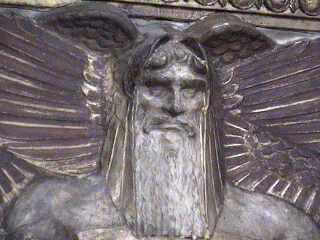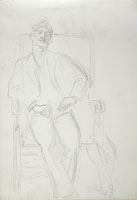|
|

|
At first blush, these two works appear to have little in common, although there is that similarity of the face and beard. The important element is how Sargent addressed the symbolism of the Spirit of Jehovah once Moses comes down from the mountain with the tablets. It is at the exact point of Exodus 34:29-30 29 When
Moses came down from Mount Sinai with the two tablets of the
Testimony in his hands, he was not aware that his face was radiant
because he had spoken with the LORD. 30 When
Aaron and all the
Israelites saw Moses, his face was radiant, and they were afraid to
come near him.
(New International Version) So how was Michelangelo to address a “radiant” face without disfiguring it? He does it through symbolism. Now in the Hebrew bible the english word “radiate” is “karan” but karan can also mean “grew horns”. Some have speculated that Michelangelo used this double meaning to achive what he wanted. (The rays of Michelangelo) So in Michelangelo’s case, the spirit of Jehovah is beaming out of him – sort of like horns -- it works. And it is this type of interpretation of Moses which would become conventional in expressing a very difficult concept in art. Now when Sargent is faced with the same problem, he has already established the language of his symbolism in "The Israelites Oppressed" -- the lunette directly above the mural of Moses. Within that, Jehovah is symbolized as a flurry of winged activity coming down to protect his people. Therefore, in Sargent's Moses we see his entire being enveloped in the spirit of Jehovah with many wings, and instead of two horns – why of course, the tip of two additional wings at the top of his head -- almost horns. He even has wings that flow down on either side of his face like long hair. John Singer Sargent  Moses (close-up) Thus Sargent treated his subject “conventionally” which would add to the Iconic nature of its medium and style. You can even see that Sargent had toyed with a more faithful interpretation of Michelangelo’s Moses in one of his drawings John Singer Sargent  Sketch of Seated Man 1890-1895 The reference is so obscure that I didn’t think it had anything to do with Moses until I learned about Michelangelo’s. But it must be a study for Moses as the verso of this drawing is one that has been identified as being of Moses. Moses (North Wall - Sargent Hall) Boston Public Library murals Note
|